Tip: How to Pasteurize an Egg
- By: Hallee
- On:
- 18 Comments
 Since posting my recipe for homemade mayonnaise, it has come to my attention by more than one person that there is a fear of getting sick from the raw egg yolk used in the recipe. A good friend of the family (and eventually a guest blogger with recipes for all kinds of yummy and authentic French cuisine if she will just heed my pleas) provided me with information on how to pasteurize an egg yolk which should eliminate these concerns. I tested this technique today to ensure that my mayonnaise recipe still works and I am happy to report that it works — to all appearances and taste — exactly as a raw egg works.
Since posting my recipe for homemade mayonnaise, it has come to my attention by more than one person that there is a fear of getting sick from the raw egg yolk used in the recipe. A good friend of the family (and eventually a guest blogger with recipes for all kinds of yummy and authentic French cuisine if she will just heed my pleas) provided me with information on how to pasteurize an egg yolk which should eliminate these concerns. I tested this technique today to ensure that my mayonnaise recipe still works and I am happy to report that it works — to all appearances and taste — exactly as a raw egg works.
I will be honest, now, and tell you that I– personally — do not intend to pasteurize my eggs. This was a family decision. The possibility of sickness from consuming a raw egg is not a deciding factor for our family while the certainty of getting more nutrition from raw foods over cooked foods is more of a factor. Kelly The Kitchen Kop (who has been a guest blogger here — hint, hint Sabine), a good friend of ours and a lady I respect so very much, recently asked and answered the question, “Are Raw Eggs Safe To Eat?” Her post is packed with a lot of really good information and also helped to solidify our personal decision with respect to raw egg.
However, if this information is useful to you and blesses you, then I’m happy and blessed in return that I am able to provide it. Please continue to give me feedback because the chances are that if you have a question or a concern, other readers have the same question.
How to Pasteurize an Egg
The following information is the technique needed for the pasteurization of an egg, and you can use this technique for any mayonnaise or hollandaise sauce recipe or similar.
Separate your yolks from your whites, and reserve the whites for another usage, such as royal icing, meringues, soufflés, a spinach eggwhite omlete, or an Angel Food cake. You get the idea.
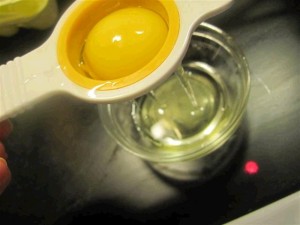
Fill a metal bowl with enough cold water to cover the egg yolk. Gently place the yolk in the bowl.
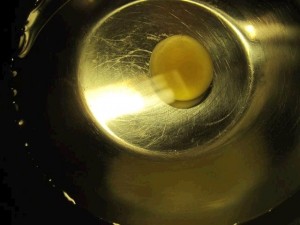
Fill a saucepan with some water and heat to boiling. Place the metal bowl over the saucepan (or you can use a double boiler if you have one — which, oddly, I don’t – ha!).
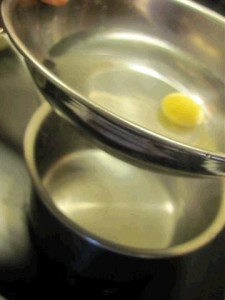
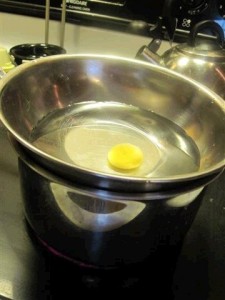
Pasteurization of an egg happens when you heat it to 140-150° degrees F for about 3-5 minutes. Any higher than that will start to cook your eggs, so you need to be careful.
Use a thermometer. When the water temperature that the egg is in reaches about 135° degrees F, take the saucepan off of the heat — the water underneath is still producing steam which is still heating up the water in which your egg rests. Start your timer, and time it for 5 minutes.
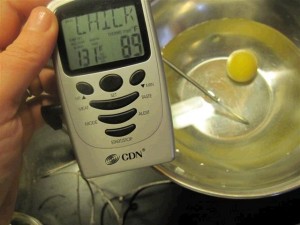
I had to take the bowl off of the pan for about a minute because it was heating up quickly and I’d gotten to 146° degrees F and was still rising. When I pulled it off, the temperature went up a couple of degrees then started to come back down. By the time the timer went off, it was still hovering around 140° degrees F.
Gently drain the egg and use it in your recipe. Here is the mayonnaise I made today with the egg I pasteurized as pictured above:
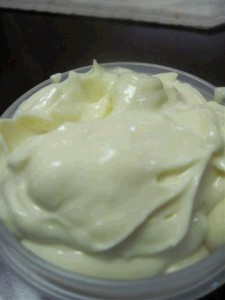
Hallee
I’m so grateful for your visit, today.
You would bless me if you added me to your ![]() feed reader or subscribed
feed reader or subscribed  via email.
via email.
You can also become a fan on ![]() Facebook or follow me on
Facebook or follow me on ![]() Twitter. I would love to see more of you!
Twitter. I would love to see more of you!
Comments are closed.


Very cool tip, Hallee. Thanks for sharing it!
I am one of those who fears raw eggs and for good reason. I got sick tasting batter the night before leaving for vacation and to postpone. I’ve had food poisoning three times in the last ten years and 0 times before that. Once very severe so I am skittish, but having said that I really like the idea of homemade mayo and I appreciate this post.
thanks for this post! although i’m not really the type to fear eating raw eggs, everytime i mention it, everybody around me freaks out. i wanted to add a raw egg to my milkshake though so i was just thinking safety first.
but you usually make your recipes without pasteurizing the egg right? and you’ve never had an incident? sickness or anything? just wondering. thanks!
I’ve never had an incident of sickness, even when I use unpasteurized raw eggs.
Thank you for sharing this information of using raw eggs to make mayonnaise. I have been thinking of making the mayonnaise just like my mom did but wasn’t sure of the raw eggs. It was fine for me when I was young, but….. I know feel comfortable making it for my kids. If you don’t mind I will share this information on my blog for my friends and family.
I don’t mind at all. I’m happy you’re sharing it.
can you do the whole egg or just the yolks?
You can do the entire egg.
So cool! Thank you so much!
Wonderful info and the Mayo recipe sounds perfect. I was having a little trouble trying to get yogurt mayo to taste like real mayo. So with pastuerised eggs I wonder how long the mayo would stay good in the fridge. Would you have an idea? Thanks so much.
Everything says use within a week. I’ve had mine last longer – I just smell it to see if it’s still good. Sally Fallon in Nourishing Traditions says that if you stir in a Tablespoon of whey into the mayo, leave it out for a few hours, then refrigerate it, it will be good for a couple of months. I have not tried that.
At a health food store purchase charcoal. I have used it multiple times for food poisoning, and salmonella. The people at the store can give you directions and warnings. I have also used it as a pultice for a poison spider bite. It is great stuff and every household should have it. :-)
I too have had food poisoning after eating food containing raw egg. I will never do that again. So thank you for the info on pasteurizing my own egg and for the mayo recipe. Cant wait to try it.
Can you pasturize more than one egg at a time?
I don’t see why not.